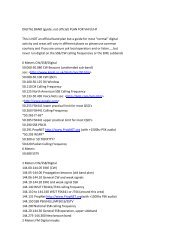You also want an ePaper? Increase the reach of your titles
YUMPU automatically turns print PDFs into web optimized ePapers that Google loves.
4.2.5.1.7. Squelch Speed<br />
This control allows the user to adjust how fast the Squelch control responds. The bigger the number<br />
the slower the action. In poor signal conditions, the slower squelch is better.<br />
4.2.5.1.8. AFC Limit<br />
This sets how far the AFC control will follow a signal. It places boundaries of +/- limit Hz on the AFC<br />
operation.<br />
4.2.5.1.9. Frequency Display Setup<br />
This allows the user to select the minimum and maximum frequency range to be displayed.<br />
Normally this should be the range of one's IF filter. Displaying spectrum outside the passband of your<br />
receiver wastes screen area.<br />
The Waterfall Color button invokes a dialog box to select a palette file( *.pal) that can be used to<br />
change the color scheme of the waterfall display. The palette file format is compatible with Nino Porcino's<br />
"Stream" program palette files and so one can use them or make their own using a text editor like<br />
"Notepad".<br />
The file consists of 256 lines where each line contains three comma separated numbers<br />
representing the intensity of RED,GREEN, and BLUE. Each numbers range is 0 to 255, where 255 is<br />
maximum intensity.<br />
Each line represents a signal level where the first line is maximum signal strength and the last line<br />
represents the minimum signal strength.<br />
The program defaults to a standard color scheme if no file is ever specified or if a filename is given<br />
that does not exist.<br />
4.2.5.1.10. Sound Card<br />
This allows one to chose an alternate sound card if one has more than one installed.<br />
4.2.5.1.11. PTT Comm Port Setup<br />
This dialog is used to enable the use of the PC serial port for turning on and off your transmitter. The<br />
RTS or DTR signal pins are set high(+8 to +12 volts) when the transmitter is to be activated and are low(-<br />
8 to -12 volts) when receiving. See the hardware setup section for details on using these signals for PTT.<br />
If no serial port is available, all the selections will be grayed out.<br />
4.2.5.1.12. Sound Card Clock Adjust<br />
This control is used to compensate for soundcards that are not on frequency. If the majority of<br />
<strong>PSK</strong>31 signals you are receiving have a "Clk ppm" value greater than about 1000ppm as displayed on the<br />
lower status bar, then you need to increment(or decrement) this adjustment value by roughly the<br />
negative of that value.<br />
Example: If most of the signals you receive are displaying around –1800 as shown above for the "Clk<br />
ppm" value, then increment the SoundCard Adjustment value to +1800. Now most of the signals that you<br />
receive should be under +/-500ppm.<br />
Remember that the "Clk ppm" value is ONLY valid while receiving a good quality <strong>PSK</strong>31 signal and it<br />
takes 10-20 seconds to get a good average value.<br />
This method makes the assumption that the majority of soundcards on the air are on frequency<br />
which appears to be the case in actual monitoring during a busy weekend.<br />
It appears that if a sound card is off it is off by over 2000ppm. Don't be concerned about clock errors<br />
under 1000ppm.<br />
7/27/01 Moe Wheatley, AE4JY 13



